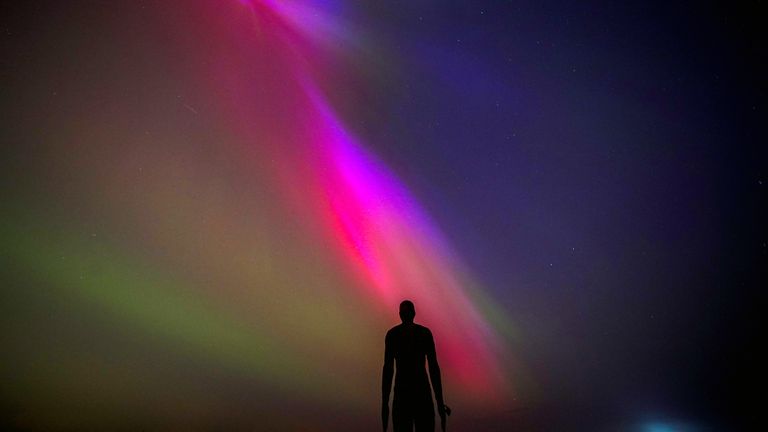The Northern Lights could light up our skies again as early as next month.
Skies over the UK turned pink and green last weekend as the Northern Lights produced incredible displays for skygazers.
The spectacle came after the National Oceanic and Atmospheric Administration (NOAA) in the US issued its first severe solar storm warning since 2005 as a series of solar flares combined to form a huge burst of solar plasma.
“We had a quite enormous sunspot, about 15 times the size of the Earth, on the Earth-facing side of the sun,” said Krista Hammond, a space weather expert at the Met Office.
“It was releasing a lot of solar flares and coronal mass ejections which are enormous eruptions of charged particles.”
A number of the eruptions caught up with each other, which meant that by the time they arrived on Earth, the resulting geomagnetic storm was much stronger than any of the individual eruptions would have caused in isolation.
“The last time we saw a geomagnetic storm of this magnitude was back in 2003,” said Ms Hammond.
The sun is in the most active period of its 11-year cycle, which means we could get another chance to see the Northern lights in the next few weeks.
“The sunspot region, which gave all the solar flares and the coronal mass ejections, is now rotated round to the other side of the sun which isn’t facing the Earth,” Ms Hammond said.
“But in a couple of weeks’ time, that area will start to rotate back around to face the Earth again.”
The lights, or aurora borealis, appear in the sky when electrically charged particles from the sun travel across space and collide with Earth’s atmosphere.
Most of these particles are deflected away, but some become captured in our magnetic field, accelerating towards the north and south poles.
This is why we usually see the lights near the magnetic poles. Occasionally, however, solar storms are powerful enough to make them visible further away from the poles.
When the sun is at its least active in its 11-year cycle, a period known as “solar minimum”, we observe about one of these ejections a week. At the current point in the cycle, the “solar maximum”, we see an average of two to three per day.
For a huge, visible display such as last weekend’s, a number of factors need to coincide, according to Sky News meteorologist Kirsty McCabe.
“The timing is crucial. First up, you need an active sun firing out coronal mass ejections.
“Secondly, these bursts of solar eruptions need to be aimed at the Earth. Then if the solar activity is strong enough, it will cause a geomagnetic storm when it collides with our magnetic field.
“The higher the level of geomagnetic activity, the greater chance of seeing the lights right across the UK, so ideally we want a G4 or G5 geomagnetic storm. Then it comes down to timing, we need the greatest activity to occur during our nighttime.
“And finally, the weather plays a big role too, as clear skies are pretty important to see the aurora,” said Kirsty McCabe.
The sun takes about 27 days to spin on its axis, which could mean we see another display from the same area of the sun at the beginning of June.
“It’s not easy to give a long heads up on possible sightings, so it’s worth keeping an eye on aurora watch websites and apps, especially as 2024 has been labelled the Year of the Aurora,” said Ms McCabe.
The solar activity does cause problems here on Earth, particularly in systems reliant on satellites.
Elon Musk’s Starlink satellites, which provide internet connections in remote areas, were “under a lot of pressure” during last week’s solar storm, he claimed on X.
Tractor maker John Deere warned customers its GPS systems were “extremely compromised” by the storm.
And some parts of New Zealand’s national electricity grid were switched off to “prevent damage to equipment”, according to the provider.
Ms Hammond suggested that last weekend’s display was “quite an unusual situation”.
However, many people keen to get a glimpse of the magnificent Northern Lights could still be in luck.



























